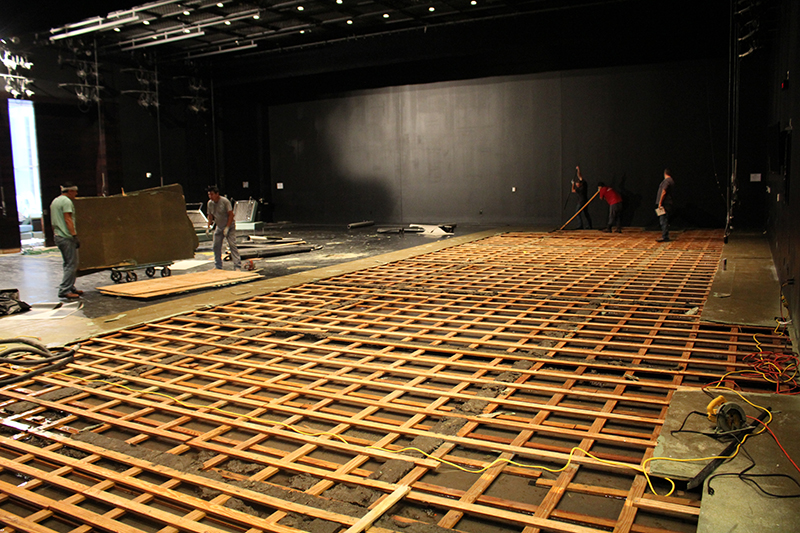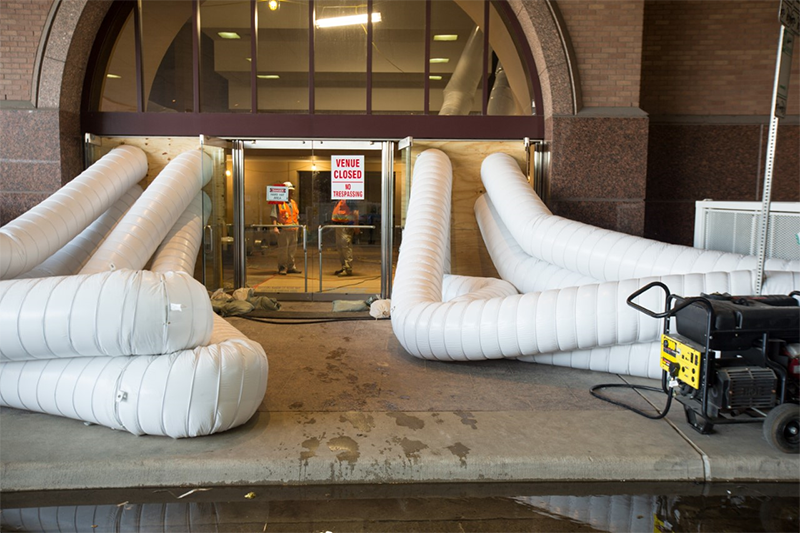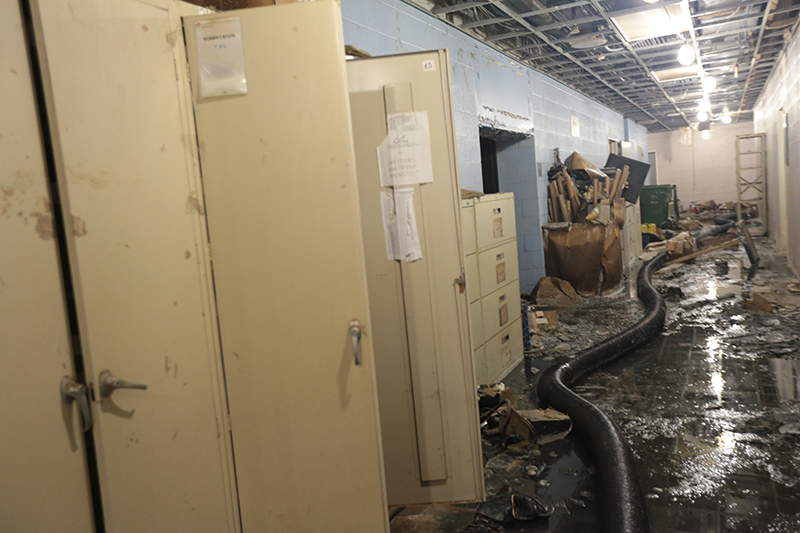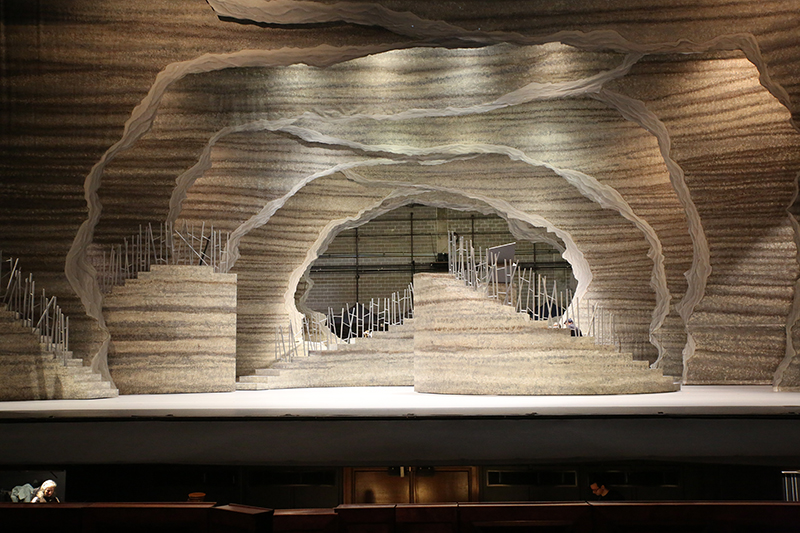
Despite losing its home in Hurricane Harvey in 2017, the company never missed a beat.
There wasn’t time to spend in shock and despair after Hurricane Harvey’s floodwaters receded from the Wortham Theater Center, said Andrew Nielsen, director of production for the Houston Ballet.
“Five days after the flood hit, we were re-planning for our Mayerling to go into another theater,” he said. “We already had the trucks loaded to do the North American premiere of the ballet when the hurricane hit.”
Hurricane Harvey became the wettest tropical storm on record in the United States, dumping 51 inches of rain on south Texas over the course of nine days, with Houston taking the brunt of the flooding and the 130-mile-per-hour winds. The Category 4 storm affected 48,700 homes, destroying about 1,000 of them completely, and damaged nearly 700 businesses in south Texas.
“Although the Theater District experienced unprecedented damages, the Wortham suffered the most by far,” wrote Olivia Pulsinelli of the Houston Business Journal. “Over 12 feet of floodwaters inundated the Wortham’s entire 150,000-square-foot basement, which included performance and rehearsal spaces plus rooms for props, wigs, costumes and more. Floodwaters also damaged one-third of the facility’s 60 air-handling units, and electrical, plumbing and elevator systems below the ground floor all suffered extensive damage.”
The ballet’s production staff took in the sight of swamped basement hallways, lockers filled with drenched boxes of shoes and costumes, breeched acoustical ceiling tiles, waterlogged stage systems, the flooded orchestra pit, ruined Marley stage floors, spongy carpet, peeling paint, mud, and standing water…and began to move on.
Houston First, which operates the Wortham Theater Center, worked with FEMA and engaged Gilbane Building Co. to begin the initial recovery and restoration work and preserve the integrity of the building. The ballet’s technical staff, meanwhile, focused on the season’s upcoming commitments. Canceling performances was out of the question; the shows would go on…somewhere.
“Within four or five days after we got back into the city, we had secured the Hobby Center for the Performing Arts to do our first production,” said Nielsen.

Ballet on the Move
Normally, the Houston Ballet shares the Wortham Theater Center with the Houston Grand Opera. “We go in for five weeks at a clip,” Nielsen explained. “We do two productions; in week one, we load in and tech show A, and in week two, we do dress and open it. In week three, we do a half-turn to show B and we tech it, and then we turn back to show A, do another three or four performances, and close it. In week four, we switch to show B, do dress and three or four performances, and then close it and load out in week five. But because of the Harvey relocation, we couldn’t find theaters that could give us five weeks.”
Instead, theaters offered them a weekend here and there, tripling the number of load-ins the ballet would have to do throughout the season. “So we could get the Hobby Center for a week, but on Friday and Saturday of that week, they had a rock concert booked,” Nielsen said. “While that was happening, we had a touring engagement in Minneapolis. So we tech’ed one show here, turned the theater back for the rock concert, flew up to Minneapolis, flew back, and turned the Hobby Center again for more performances.”

He added, “I do want to make mention of IATSE Local 51. Obviously they got a lot more work out of Harvey, but we have a core group of stagehands who work with us, and I have never seen a group of stagehands come together that way to make just about anything possible. We couldn’t have pulled it off without them.”
Renting other stages in Houston posed greater challenges than timing, Nielsen said. In a normal year, the Houston Ballet presents its season in the Brown Theater within the Wortham Center, which is one of the largest stages in the country. “The Brown has a full stage right so we can send an opera wagon back there, and a full stage left as well,” he said. “These sets don’t fit in other buildings. So we had to modify all of our productions to make that work.”

The Brown’s stage floor had been purpose-built to support gargantuan grand opera wagons on a solid floor, while simultaneously providing flexibility for ballet dancers. “Inside there’s a series of interlocking mechanisms,” Nielsen said. “They rotate down to make the stage more solid, and then we rotate them up when the ballet is there. So we don’t have to perform on a portable spring floor like most dance companies. This also means that our scenery is bigger and heavier than most ballet companies. Our Nutcracker house is 14,000 pounds — you can’t put that on a portable sprung floor. So none of the other venues met the dancers’ union specifications.”
The Houston Ballet had to make an immediate and significant investment in a portable sprung floor, so Nielsen turned to Larry Sullivan at Harlequin Floors for assistance. “We had to rip out all the Marley floor, it was just ruined,” Nielsen said. “Within two weeks after the storm hit, Larry and his crew were already down here installing our studios. Then we had that middle-of-the-night thought — ’We’re going to the Hobby Center and we need a sprung floor!’ — and we needed eight carts of sprung floor panels in four days.”
Sullivan, contracts director for Harlequin, got the order and shipped it the same day. “We shipped down some of our Liberty touring panels,” he said. “Customers like Andrew, the biggest players in the industry, they know what they need.”
Harlequin also helped Nielsen address a well-known issue in ballet companies: the aluminum boom towers that provide side light at stage level. “The towers don’t like sprung floor, but they made us a special floor for this,” he said. “What Harlequin pulled off for us was unbelievable. The customer service and attention they gave us was just remarkable.”
Sullivan shrugged off the compliment. “There are no heroes here,” he said. “It’s a partnership, it just works. At the end of the day, we’ve done our job, everyone’s happy.”
As the season resumed in theaters across the city, the company found ways to modify and move its often-massive sets into new spaces, and to recreate effects that made its ballets magical for audiences. Nielsen called on suppliers including Rose Brand for soft goods and Creative Conners for synchronized stage movement.
“When I talked to Andrew during and after the devastation that Houston had, he was in the middle of figuring out what they were going to do,” said Matt Biringer, sales representative at Rose Brand. “He was the driving force to help us help him.”
Nielsen sent detailed drawings to Biringer for replacement soft goods for a dance lab. “Legs, borders, cycs, scrims, they were all ruined,” Biringer said. “Hampers, sandbags for storing things temporarily, a fair amount of yardage. We made these very quickly. They ordered some things Sept. 18, and we shipped them on the 20th to the Hobby Center. We knocked those out super-fast and got them out. And there were logistical issues we had to figure out. We couldn’t get ground trucks into Houston, so they had to be shipped air freight.”
Rose Brand tackled an unusual project for the company as well: covering a plywood ground row with fabric. “We have the capacity to do that, but it’s not something we do for everybody,” Biringer said. “It was an incredible effort for them to deal with all the found spaces over the course of the year — just getting the dancers and scenery and the techs, while many of them were dealing with tragedy of their own, houses damaged, lives lost. Andrew was the right person to head this, because he’s very capable.”
Buying a theater’s worth of new soft goods is no small expense, Biringer noted, but Rose Brand made a conscious effort to mitigate that. “A lot of the time it’s like, ‘What do you have to spend, Andrew, and what can we do?’ We have a philosophy here to not hit anybody when they’re down. We try to make it work.”

An Itinerant Nutcracker, and Beyond
Remounting the company’s legendary production of The Nutcracker during the holiday season proved especially challenging. “We had to perform it, a 24-truck production, in venues we’d never been in,” Nielsen said. “Rose Brand had done all the window curtains for the house in red velour. We designed and built a ‘Venestrian’ curtain — a combination of Venetian and Austrian. I got in touch with Creative Conners and said, ‘Can you bring this curtain to life? Can it poof open and have Drosselmeyer and the mice come through it?’”
The answer was a resounding yes, resulting in the purchase of several Stagehand motion controllers and six chain motors that Creative Conners customized to automate the curtain and its batten. “We rented some Pushsticks [zero fleet-angle deck winches] from them as well, so we could get the total of the 11 points that we needed,” Nielsen said. “Some of the points in the curtain had to be much faster than the variable speed chain motors, so they did that for us.”
“We had just been developing a smart chain hoist at that point,” said Mike Wade, director of technical services at Creative Conners. “It seemed like those actually fit the bill for what Andrew and the ballet had to accomplish, having to be nomads for their Christmas season that year. These chain hoists and station controllers and full control system for them were probably going to be the best path forward.”
The system worked so well that Nielsen engaged Creative Conners to provide the new automation systems the ballet uses in the Brown Theater. “We work in close collaboration with the technical staff to determine their path to execution,” said Wade. “We helped them automate a couple of linesets with high-speed, 100-feet-per-minute chain hoists. We utilized those and our traditional spot line hoists to create a big Austrian hoist system, to make their drape pretty.”
With the annual Nutcracker behind them, the staff focused on their biggest challenge of the season: the world premiere of Sylvia, a new staging by Houston Ballet’s artistic director, Stanton Welch AM, and a co-production with the Australian Ballet.
“It has nine portals, and it had to be able to fit into the Sydney Opera House,” said Nielsen. Well-known ballet and opera scenic designer Jerome Kaplan and projections designer Wendell Harrison, who created Tommy on Broadway, teamed to create the scenery, with lighting provided by resident designer Lisa Pinkham.
“It was all to look like it was chipped-out rock,” said Nielsen. “We also had five of what we called trees, but they were a combination of the Rose Brand fabric Kaos, backed with some scrim and a third fabric. They were all intended to be projection surfaces. Some were a half-stage panel, and some were 10 feet wide and formed the shape of a ‘V.’ Sylvia is about Greek mythology, so we needed to have the world of the gods and the world of the mortals. So we called Creative Conners and said, ‘Hey, we don’t want to go through a tech process of having 10 stagehands trying to coordinate all those traveler pulls and in-and-out pulls. This is insanity.’”
Linking precision movements with projections is Creative Conners’ stock and trade, so they saw immediately that they needed to use motors with airplane cable rather than rope to facilitate the movements. “We agreed, but there was no such product available,” said Nielsen. “So they invented the Pushstick Mini.”
The small, lightweight winch measures 36 by 22 by 11.5 inches and only requires 120 volts of input power, but it can be used as a deck winch or for curtain or scenery track overhead. It uses 3/16-inch wire rope with up to 85 feet of travel, fitting the bill for SYLVIA’s exacting requirements.
“We bought five of these things, and we had one traveling with each batten in and out, and it was stunning,” said Nielsen. “We got the first five, and they are really proud of what they were able to produce.”
Nielsen next approached Harlequin Floors for a vinyl floor using a specific shade of gray, one used with other Harlequin products, but not with the floor he wanted. Harlequin now offers its Reversible Pro floor in this darker gray.
“I think one of the things that I have found remarkable is the products that we have helped invent/create, that these companies can now market,” Nielsen noted.
The Brown Reopens…Mostly
Little more than a year after the flood, the Brown Theater opened its doors to audiences on September 25, 2018. The stage was ready for its first production, but in the rest of the building, work continued — especially in the basement, where dressing rooms and other basic functions remained out of commission.
“The biggest struggle was that all but seven dressing rooms are in the basement of the Wortham,” said Nielsen. “So as I sit on the phone with you today, the basement has not yet been released to any clients. They tell us the anticipated date for access is June 17 — a week before we close our season. Each of our full-length productions has upwards of 100 people.”
With no green room, areas for dancers to wait while offstage, laundry facilities, and other accommodations, the company still had to scramble to perform on its home stage.
“We found a laundry trailer through a remediation company in Ohio with eight washers and dryers, and we spent between $40,000 and $50,000 renting that and parking it outside our theater,” he said. “Then we had to work with the city, because all the runoff water had to be drained every six days, and the propane for power — that was a big expense.”
Dressing rooms convenient to the stage became a major priority as well. The company considered using its administrative offices, but these would have required the cast to cross a sky bridge. “The door system wasn’t working because the security system was flooded,” Nielsen said. “So we ended up buying 20 yurts, and we created a little yurt village behind the theater that became the dressing rooms for the entire season. ‘Yurtville’ is what we call it. We had to run fans to keep them cool, and install paging systems.”
Storage for sets in the company’s repertoire also has not yet become available. “Once a show closes, we put it back in the truck because there’s nowhere for it to go,” he said. “So it’s finding all of these challenging solutions for things you don’t think about until you’re displaced.”
Nonetheless, the Houston Ballet performed its 2018-19 season in the Brown as scheduled. It does appear that life may return to normal shortly.
“We’re just glad to be home,” Nielsen concluded, “and not wondering where we have to be next.”


